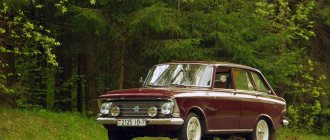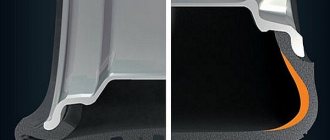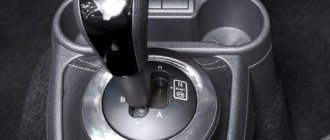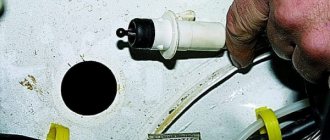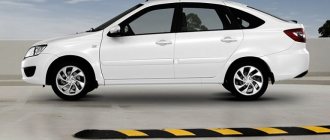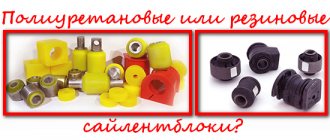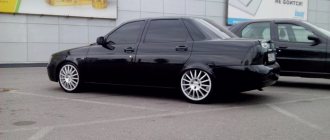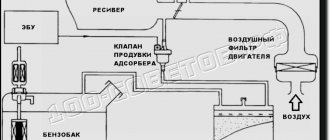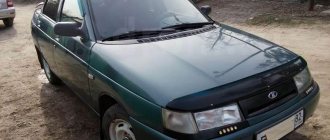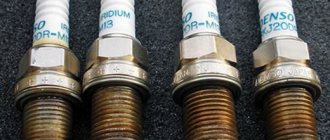Suspension is one of the most important elements in the design of a modern car. It is the suspension, also known as the suspension system, that serves as the connecting link between the load-bearing part of the body and the wheels of the car. Complex components and suspension mechanisms are designed not only to reliably connect, but also to transfer to the body the forces that arise when the wheels come into contact with the road surface. Thanks to the correct functioning of the suspension, the optimal position of the wheels in relation to the frame or body, as well as the required smoothness of the vehicle, are ensured. During the development of the automotive industry, the suspension design has undergone many changes. A significant increase in speeds and high demands on controllability and stability led to the creation of a system called McPherson.
MacPherson suspension device
MacPherson suspension is one of the most common types of car suspension (in English - MacPherson suspension).
In this article we will learn what a MacPherson suspension is, its main pros and cons, and also consider the diagram and design of this suspension. The main structural element of the suspension is the shock absorber strut, which is why it also received the name “swinging candle”. "Candle suspension" is mainly used for the front wheels. The version for the rear wheels in English-speaking countries is called “Chapman suspension” in honor of the Lotus engineer who developed it. The use of MacPherson suspension made it possible to place the engine and gearbox transversely in the engine compartment and led to its widest use in the modern front-wheel drive automotive industry.
MacPherson suspension consists of:
- stretcher
- wishbone
- rounded fist
- shock absorber strut
- anti-roll bar
Most McPherson modifications include the following structural elements: anti-roll bar, shock absorber strut, steering knuckle, wishbone and subframe. It is also possible to use a torsion bar as an elastic element. The main load-bearing element of the suspension is the subframe.
It is attached to the car body using silent blocks. The use of rubber-metal supports reduces noise and vibration transmission to the body. The subframe serves as the basis for mounting the steering gear, wishbone supports and anti-roll bar.
The transverse arms are attached to the subframe on both sides using rubber bushings.
right and left wheels.
The levers are double fastened, which gives the structure rigidity in the longitudinal direction. A steering knuckle is attached to the other end of the wishbone through a ball joint. The steering knuckle
is attached to the steering rod by means of a swivel joint, allowing the wheel to turn.
The upper part of the steering knuckle is attached to the shock absorber strut, and the lower part is connected to the wishbone. It also houses the brake caliper and bearing assembly. The shock absorber strut
includes a spring and a shock absorber coaxially located with
a compression buffer
. The upper part of the strut is attached to the mudguard of the wing using a rubber bushing, the lower part is connected to the steering knuckle. Some car manufacturers separate the spring and shock absorber into two structural elements.
Six MacPhersons to choose from
Holy simplicity turned out to be quite a sought-after commodity. Only 50 years have passed since the development of the design of the most commercially profitable suspension, but today we can say that no matter what cars the design was installed on, not a single car failed in the market due to its fault. Even the most budget ones. In this regard, Fiat blocked everyone by installing an amazingly economical design on the Panda model. On Panda there is not even a lever in the full sense. A spring strut with a monotube shock absorber rests on top of the body, and from below it is held by a torsion bar anti-roll bar and a tiny swing arm, which is attached to the strut with a simple bolt. Even easier than eight. In general, over the years we can already distinguish six types of MacPherson suspensions. Since engineers have not yet given them names, we will allow ourselves to come up with our own terminology.
After General Motors, McPherson went to work for Ford
Macpherson classic
Exactly the one that rocked the Ford Consul in 1949, a similar one is installed on the VAZ. The design is distinguished by a narrow lower arm, which is tightly attached to the anti-roll bar. At the same time, both the pros and cons of this design are that the stabilizer took on too much. In addition to its main functions, it also served as an additional arm of the lower lever, preventing the car from moving to the side during acceleration and braking.
MacPherson wishbone
This scheme appeared in the early 70s on Kadett E cars. A durable triangular lever was attached not to the body, but to the subframe. The subframe hung on rubber silent blocks, absorbing all road vibrations, making the front suspension as comfortable as possible.
Nemacpherson
MacPherson, but not quite, since the short spring was installed separately from the shock absorber. The shock absorber still rested against a cup welded to the body on the wheel arch. This treacherous design proved to be much more durable than the real MacPherson. The 124th and 201st Mercedes were equipped with exactly this configuration, and the Ford Transit jumped from this design only in 2001. Reliability was ensured precisely by reducing the load on the upper support part, so you will never see a Transit with a broken support part in the upper wheel arch cup.
Springless
It’s hard to say what to call this MacPherson, since it has no springs at all. The cunning Italians instead used longitudinal torsion bars on the Fiat 130. Torsion bars, by the way, were also expected by Zhiguli, if not for the chief designer MZMA, who was part of the Fiat acceptance committee. He seriously quarreled with the Italians about this and about the lower engine, which the Italians wanted to sell to Soviet burly reception engineers. But the point is not that, but the fact that in the Mercedes Sprinter and Volkswagen LT in the 90s, this type of MacPherson was used, only with a transverse spring.
American MacPherson
This type is used only on the rear suspension. There are as many as three levers working here - one transverse and two longitudinal. Almost all front-wheel drive Americans of the 80s and 90s have such a rear suspension, and some Koreans and Japanese are not far behind them.
MacPherson Renault
This is definitely the correct name, since this scheme is used only on these French cars. To avoid all the MacPherson's handling shortcomings, of which there are plenty, the French used a kingpin. Such as on the Volga. Just not that threaded, creaking nightmare, the design turned out to be more elegant. The stand here is non-rotating, and the wheel and knuckle rotate, held in place by ball joints.
MacPherson suspension: diagram, design and principle of operation
Anti-roll bar: design, purpose, malfunctions
In the seventies, most cars, including those in the business class, were equipped with this type of suspension. Among them were quite large models Audi -100, Mercedes-124 and Opel Senator.
Subsequently, this practice had to be abandoned; mass operation revealed some design flaws that could not be eliminated without changing the design design.
Video - MacPherson suspension diagram:
The McPherson suspension has a simpler design compared to the classic design and differs from it in its operating principle. The node consists of the following parts:
- lower arm with ball joint;
- wheel hubs with brake disc;
- steering knuckle with shield and steering rod;
- telescopic stand with lower support cup;
- compression buffer with rubber or plastic protective cover;
- coil spring;
- support bearing with upper cup;
- lateral stability link with working rubber-metal elements and fastenings.
MacPherson suspension, the main details of which are shown in the list, is one of the most common schemes. There are other varieties of it, with some differences in individual details.
Thus, on the iconic Porsche 911, a torsion bar was used instead of a coil spring to reduce the overall height of the structure. A similar scheme was used in some French-made machines.
MacPherson suspension diagram
On one of the most successful Mercedes-Benz cars, model W124, the layout was changed and the spring was installed separately from the telescopic strut. A McPherson suspension device of a similar type was also found on cars of the Ford platform, which is called Fox. The potential of this design scheme has not yet been fully exploited and it has prospects for development.
Units of this type are compact and simple, which determines their widespread use in the automotive industry. MacPherson suspension is a design in which a shock-absorbing strut is attached at the top to the mudguard of the engine compartment. From below it is rigidly connected to the steering knuckle, the entire structure can rotate within certain limits. The axle passes through a bearing mounted on the body and a ball joint mounted on the lever.
The telescopic strut in the McPherson independent spring suspension performs three functions:
- determines the direction of movement of the mechanism in the vertical plane;
- dampens the resulting vibrations;
- is a kind of pivot pin for the wheels.
In general, the operation of this type of suspension is as follows: when the wheel passes over an uneven surface on the road, it rises up or falls down. The resulting load is perceived by a spring, which is compressed or, conversely, straightened. At the same time, the telescopic stand lengthens or shortens. Part of the load is transferred to the car body.
At the same time, the spring begins to straighten, restoring its shape, which leads to lengthening of the rack. Vibrations occur, which are damped by a built-in shock absorber. This allows you to minimize vertical movements of the body relative to the ground surface. When performing a maneuver, the stand assembly with the fist and the wheel mounted on the hub rotates. At the same time, the car changes direction.
Video - how MacPherson suspension works:
MacPherson strut suspension is primarily used on front-wheel drive vehicles, on which the power unit is placed transversely. It has a number of advantages over the classic double-lever layout, but at the same time, in many respects it is significantly inferior to it.
During the design process, designers have to solve the difficult task of choosing a specific design, taking into account all its features.
History of invention and development
The name of the design uses the name of the inventor, an employee of Earl Steel McPherson. This type of suspension was first used on the production Ford Vedette after World War II in 1948. The engineer initially worked at GM's design bureau on the Chevrolet Cadet, a consumer vehicle.
The model did not go into production, and the designer went to competitors, where he applied his own developments. In fact, suspensions of this type with a slightly different configuration without a transverse swing arm were used at the dawn of the automotive industry.
In the 20s of the last century, the Italian engineer Guido Fornaza developed a circuit diagram and patented it in the United States on September 15, 1925.
The layout looked familiar to us with a lower swing arm and a rotating vertical stand. The American designer Earl Steel McPherson used the general operating principle, modified it and implemented it in metal. The main difficulty at the initial stage was the low service life of the telescopic stands. With the development of technology, this problem was solved.
Initially, this type of suspension was planned to be used not only in the front of the car, but also in the rear. After much discussion, the choice was made in favor of the traditional scheme. This type of rear wheel suspension was first used in 1957 by Colin Chapman on the Lotus Elite model. Due to this circumstance, in the New World and Great Britain this design scheme is usually called the Chapman type suspension.
An alternative version of the history of the development of suspensions of this type can be considered a design with two levers of different lengths. The upper unit was significantly shorter than the lower one, and the springs with shock absorbers were located above them. This scheme is used in the all-wheel drive Niva; the shaft with an external constant velocity joint is located just between the levers.
Advantages and disadvantages of the design
Vehicle chassis design
MacPherson suspension has been used for many decades, which means that it is easy to use and has many advantages. Its advantages include:
- affordable price;
- convenient assembly from ready-made parts, which is carried out in a separate area and only then installed on the machine;
- compact design can be easily installed even in a transversely positioned engine block;
- a gap is maintained between the main components, which makes it possible to reduce inertial power;
- the design can be improved;
- if the hinge joints are worn out, this will be expressed by tapping when driving on uneven terrain, this defect can be accurately identified;
- The suspension makes it possible to place the car's engine and gearbox transversely under the hood.
An independent MacPherson strut can be used on different models of budget class cars. It is installed mainly on sedans and hatchbacks on the front or rear axles. Thanks to the suspension, cars with engines with low power improve ride quality on city highways.
Along with the advantages, the product has several disadvantages. The most important of which is the difficulty of maintenance. To replace any part in the structure, you will need to disassemble the entire suspension. This can be costly if this procedure is carried out at a service station. The device has low kinematic parameters; often the front wheel changes the angle of inclination, thus reducing stability. When driving for a long time on uneven surfaces, the suspension functions are reduced. The mudguard begins to crack during operation, making the risk of corrosion high. The shock absorber strut begins to fail under heavy loads, which can lead to disruption of the body geometry. Correcting this shortcoming will be difficult. The suspension makes noise during operation; to get rid of it, you will have to use soundproofing devices.
The presence of deficiencies does not allow the use of the suspension in luxury cars, as well as in sports models and trucks.
Despite the shortcomings, the suspension is popular and is one of the most common options for different car models. If the rules are followed, the product can last a very long time. When driving carefully, the device works properly, showing only positive characteristics.
Read further:
What is a torsion bar in a car suspension and how does it work?
Air suspension
Pros and cons of air suspension
Car suspension with magnetic shock absorbers from Bose and other companies
Toyota Hiace air suspension
Sources and notes
- ↑
- . Retrieved August 16, 2006.
- Setright, L. J. K., "MacPherson Strut: Legs to Support the Car", in Northey, Tom, ed. World of Automobiles
(London: Orbis, 1974), Volume 11, p.1235.
The VW Golf III (MK3 “Modification Kit 3”) is a compact car produced in Germany by Volkswagen from 1991 to 2002. Body types: three-door and five-door hatchbacks, Golf Variant station wagon, Vento sedan and convertible. First presented to the general public at the 1991 Geneva Motor Show. From the spring of 1992 until the end of production, the car was sold in Russia and the CIS countries, but sales of the car were small.
In the fall of 1992, the car took 1st place in the ranking of professional European journalists and became the European Car of the Year. In the 2000s, several tens of thousands of used VW Golf III cars were imported into Russia from Western countries (Germany, Belgium, Holland, Sweden, Switzerland and the USA).
The total number of cars produced was 4,805,900, including 222,626 station wagons and 43,902 sedans.
In 1998 it was modified and became a little modernized. But in the same year the next generation appears.
Coilover is an element of an automobile sports suspension. This part of the car's chassis consists of a shock absorber with the ability to adjust the stiffness and a spring on a screw bushing, which allows you to adjust the vehicle's ground clearance by compressing the spring. The shock absorber and spring are a single unit and are installed on the car as a replacement for standard components. The main purpose of coilovers is to lower the car's suspension, thereby changing its appearance and behavior on the road. Depending on the model and manufacturer of coilovers, you can reduce the vehicle's ground clearance by up to 80 mm. This type of sports suspension is widely used on both cars and motorcycles.
There are two types of coilovers. One of them allows you not to change the standard shock absorber by installing a screw thread and a spring with changed characteristics on it. The second type is a single part, which includes a shock absorber, spring, bushing, and support bearing.
What does it consist of?
The design and principle of operation of the anti-roll bar of the rear and front suspensions
The MacPherson strut suspension includes a number of components. Let's take a closer look at each type. In other words, let's study in detail the design of the MacPherson strut suspension.
- The most important thing is the subframe. It is attached to the car thanks to silent blocks. Supports made of rubber mixed with metal are also used, so the element makes less noise. A part is something that you can lean on, used to attach the steering mechanism, wishbone, stabilizer.
- Next, let's talk about transverse levers, which are installed directly on the subframe. They control the movement of the right and left wheels. The device is fastened in a double style, so the structure will be more rigid. The steering knuckle is also attached here, only at the other end of the wishbone.
- Thanks to the steering knuckle, the wheels can be turned. The fist consists of two elements. The upper bracket is attached to the strut for shock absorption, the lower one to the wishbone. Two other elements also cling to this. We are talking about the brake caliper mechanism, as well as the hub assembly with bearing.
- Now let's move on to the shock absorption strut. It consists of its own shock absorber and spring. The stand consists of two parts. The upper part clings to the mudguard, and the lower part to the steering knuckle. There are car manufacturers who divide the strut into two different parts: a spring and a shock absorber.
- And finally, let's talk about the stabilizer, which serves to reduce the lateral roll of the car. It clings to the subframe using two support sticks, which in turn are hinged to the stabilizer.
You can also talk about the torsion bar, but usually its structure is omitted when describing the structure of the suspension. Important elements have been described. It is on them that the entire suspension is built, which can last for many years if used correctly.
pros
- The suspension is an inexpensive mechanism, provided that it is assembled based on ready-made elements at a specific site with further installation on the vehicle.
- The compactness of the suspension makes it possible to install internal combustion engines oriented transversely in the engine compartment.
- Low manifestation of inertial forces, due to the significant distance of the main components from each other.
- Quickly realize that the hinge joints are worn out. A characteristic tapping sound appears when driving on an uneven road.
- The design of the suspension contains potential for further improvement of the mechanism.
Types of torsion bar suspensions
Designers have a new technical tool for implementing various vehicle layout schemes. Therefore, now you can find fully independent and semi-independent suspensions, which are equipped with cars of various classes.
Front independent
This type has become common on racing cars (for example, Porsche), commercial trucks and SUVs. To fasten the wheel and hub assembly, double levers are used, and the role of a spring is played by a torsion bar located along the body. By adjusting its length, thickness and installation angle, you can raise or lower the body and adjust the suspension for specific road conditions.
In addition to the main torsion bar, shock absorbers are installed to dampen vibrations and a stabilizer bar. In terms of handling, a car with an independent front suspension is not inferior to, and sometimes even superior to, a car with a MacPherson-type shock absorber strut.
Rear independent
The rear independent torsion bar suspension differs from the same front one. A typical representative of a car with such a design is Renault 16. It featured a design with two transverse elastic rods, one of them being behind the other. Accordingly, the mounting points for the suspension arms of the left and right wheels were slightly shifted relative to each other.
The result was a very compact and durable suspension, the luggage compartment was increased, but handling remained unimportant due to the different base of the rear wheels. Another example of rear independent suspension is the use of trailing bars and separate control arms for the left and right wheels.
This scheme is not widely used on passenger cars, but it is often found on passenger trailers and special equipment.
Rear semi-independent
A hybrid design that combines the elastic properties of a torsion bar and a rigid cross beam. In this case, two trailing arms are connected by one elastic element, so when one wheel is compressed, the force is partially transferred to the second. This does not give complete freedom to both wheels, but the handling and behavior of the car on the road is noticeably improved in comparison with a completely dependent one.
The U-shaped torsion beam always works in combination with a spring and shock absorber. Currently widely used on all budget front-wheel drive cars - VAZ, Toyota, Volkswagen, Renault and many others.
Positive and negative points
The most important thing in this device is the stand, which plays the role of a shock absorber. It is also called a swinging candle. Usually it is used only as a front suspension, but there are exceptions. Thanks to it, the engine and gearbox can be located under the hood in a convenient place. This is the best suspension in front-wheel drive cars.
Let's look at the advantages of this type of device:
- at the factory they spend less time on it during production;
- takes up little space;
- weight without spring is less than that of other suspensions;
- The upper support of the strut, which is used as a rolling bearing, is of great importance.
Now let’s look at the disadvantages of this type of device:
- kinematics are less efficient than those on a trailing or transverse link;
- the spray wing needs to be strengthened;
- it often develops tears where the suspension is attached, since it is not intended for movement over rough terrain;
- The struts needed for shock absorption often break, so their expensive replacement is required, and this work is very difficult to do;
- The car drives very noisily, so there is a hum in the cabin;
- the longitudinal roll makes a slight “peck” when stopping.
It is these shortcomings that the MacPherson suspension has that prevent it from working fully, which leads to its low use compared to new suspensions. Therefore, it is usually not installed on racing cars or expensive cars. After all, this device is subject to high consumption.
Moreover, the design of the device is such that the suspension cannot be installed on a truck. Therefore, now you can find MacPherson only in inexpensive cars, while they are almost never found in luxury cars.
Device
The MacPherson front suspension consists of a lower trailing arm, which is mounted on a subframe and provides the functioning of the main structure. The swing amplitude of the mechanism is quite wide, with a power reserve. The lower wishbone is a load-bearing one; a telescopic stand, the so-called spark plug, is directly connected to it on a hinge.
In the upper part of the rack, in the area of its thickening, the upper lever is mounted on special brackets. The rotary stand is connected to the structure via silent blocks. All parts are arranged in such a way that on a front-wheel drive car, the axle shaft with the CV joint at the end passes unhindered to the wheel hub. The lower wishbones are connected by a stabilizer bar, which suppresses the vehicle's sway and leveling.
Engineer McPherson tried to use the suspension he developed on the rear wheels and even installed it on the Chevrolet Cadet model, but the design could not withstand the loads, and the car had to be returned to its previous state with the rear axle placed on springs. This happened in 1955, and since then there have been no further attempts.
Distinctive characteristics
If we compare McPherson's development with the previous version of the automobile suspension, the main difference here is that the ball joint was moved to the upper extreme point of the shock absorber strut.
At the same time, the hinge changed, and the support became a radial-type ball bearing. From now on, the entire load falls on the top of the rack. Previously, stamped mud flaps made of thin metal were used in the engine compartment. The main unit was attached to it. But with the advent of the MacPherson suspension, such a mudguard could no longer fulfill its tasks, so they had to strengthen it several times. Having gone through all the improvements, the new version of the car suspension received a simplified design, but fully complied with all current safety requirements. The main peak of popularity occurred in the 70s of the last century. From that moment on, the active use of the development of engineer Earl McPherson began, which has not declined to this day. This is due to the appearance of a telescopic shock absorber strut, the service life of which has increased significantly. It was the new shock absorber that made the MacPherson suspension a real bestseller of its time, and also allowed the device to remain relevant to this day. New developments in the automotive industry have made Earl's suspension technologically advanced, but at the same time very cheap to manufacture. Therefore, MacPherson is actively used on budget and middle class cars.
McPherson suspension device
The McPherson suspension is essentially a slightly modified system with two levers, only instead of the upper lever, its function is performed by a shock absorber support, which is fixed in the upper part of the body under the wing of the car, and from below it connects the lower lever and the ball joint. Generally speaking, the McPherson suspension design is simple, which makes it possible to carry out repair operations in a garage environment. The main structural elements of the McPherson include the lower wishbone, shock absorber strut, subframe, wheel hub, ball joint, shock absorber mounting support, and spring. The car subframe, using silent blocks or rigid fasteners, is attached to the car body; its main task is to reduce the effect of suspension vibration on the body. In some cases, the subframe may be missing. In this case, the lower arms, which must be attached to it using silent blocks, are attached to specially reinforced platforms on the body itself. A characteristic feature of the lower wishbones is the presence on one side of two support points on which it is attached to the subframe or to the car body, and on the other side a ball joint is attached to it with the help of which the steering knuckle can rotate in any plane.
MacPherson suspension diagram
There is a hub on the steering knuckle, which secures the wheel and rotates it with the help of a bearing installed in it. The upper part of the swing arm is connected to the shock absorber strut, the upper part of which is movable due to, in most cases, a rubber bushing with a bearing in which the shock absorber rod is mounted. The support bearing ensures rotation of the strut around its axis, and the rubber bushing compensates for its deflection that occurs during operation of the McPherson suspension. I would also like to note that the shock absorber strut is located inside a spring, which provides additional elasticity to the suspension.
For more advanced performance, the McPherson suspension may have a number of additional elements, such as stabilizer bars and anti-roll bars themselves, which ensure the vehicle's stability when cornering. The stabilizer is attached to the subframe or to the car body at two points using metal brackets, inside of which there must be rubber bushings that ensure softness of the suspension at the attachment points.
Pros of McPherson suspension
- Low element manufacturing costs compared to double wishbone suspension
- Easily diagnosed and repaired
- Compact
- Unsprung weight is less than other suspensions
- Longer service life of individual elements.
Disadvantages of McPherson suspension
- The kinematics parameters are somewhat worse when compared with a double wishbone suspension
- Increased transmission of road noise into the body and interior of the vehicle
- Less compensation of longitudinal roll during braking compared to other suspensions.
- Frequent failure of shock absorbers
avtoexperts.ru
Today, most cars are equipped with a suspension named after its inventor, the American engineer Earl Steely McPherson. Moreover, it is installed on both the front and rear axles of the car. What is the secret of the popularity of this pendant, what are its advantages and disadvantages, we will tell you in this material.
History: ingenious replacement
Since automobile companies switched to mass production of cars that used various types of independent suspensions, there has been a constant search for the most optimal design. By the 1940s, in particular, an independent double wishbone suspension was invented, which gained popularity among manufacturers due to its universal functionality - the engineer could strictly adjust its settings, choosing, depending on where the car would be used, a certain geometry of lever placement. It was during these years that a group of engineers, including Earl Steely McPherson, worked on the creation of a new budget Chevrolet car in the United States. On the prototype of the new model, which was called Cadet, he proposed installing an improved version of the independent suspension on double wishbones. This improvement involved the replacement of the upper arm with a ball joint and shock absorber with a shock absorber strut, which articulated with a swivel joint mounted on the mudguard. The result was a design that was more compact, lighter and had fewer parts than a double wishbone suspension.
However, this design was not destined to go into production, since the development of the Cadet model was curtailed. Unable to find support at General Motors, Earl McPherson went to work for Ford. There, the design he invented was treated with great attention. The first production car to use MacPherson suspension was the 1948 Ford Vedette.
This model was produced in France and was intended for the European market. Subsequently, this suspension was installed on the Ford Zephyr and Ford Consul models. Then this type of suspension, with some modifications, began to be installed on models from other manufacturers. MacPherson suspension became widely used in the 1970s and is currently widely installed on different classes of cars.
Device: at the forefront is the shock absorber strut
It was this shock absorber strut that became the main structural element of the suspension, due to which the design of this unit was greatly simplified. In addition to the shock absorber strut with a coil spring, which is articulated at the upper end with the mudguard, the suspension includes a lower wishbone, a tie rod or anti-roll bar, a steering knuckle and a steering linkage.
By the way, there are car models where the coil spring and shock absorber strut do not form a single whole, but are structurally separated. This suspension is installed on Mercedes-Benz, Ford. There are MacPherson suspensions, where the role of an elastic element is played by a torsion bar, replacing a coil spring. The Porsche 911 has this type of suspension.
An important parameter of this suspension is the angle of inclination of the shock absorber strut - a distinction is made between longitudinal and transverse inclination angles.
Mostly this suspension is installed on the front axle, although there are cars that have a suspension of the same design on the rear axle. However, it goes by a different name - Chapman suspension, in honor of Lotus engineer Colin Chapman, who developed a similar design, which, however, was more suitable for installation on the rear axle.
Pros and cons of MacPherson suspension
Despite the widespread use of this type of independent suspension, it had both advantages and disadvantages due to which, in particular, many manufacturers abandoned the use of MacPherson struts on their models and returned to improved double wishbone suspensions.
However, thanks to the advantages that Earl McPherson himself highlighted during the development process, this type of suspension design is still the most popular. How did she manage to conquer the automotive world? The advantages of this type of suspension include compactness, low mass of unsprung elements, and relative low cost of production. In addition, due to the significant distance between the support units in height, such a suspension better compensates for the reaction forces of the road, which are transmitted from the wheels to the places where it is attached to the body. Also, this suspension can produce large design strokes, which is also a positive aspect of its design. Finally, its thrust bearing, lower arm and ball joint are highly durable.
Let's move on to the disadvantages. MacPherson strut suspension has greater suspension travel than the same design with double wishbones, and this negatively affects the car's handling. The second disadvantage is that the reaction forces from the road are transferred to the mudguard of the wing, which is not the most reliable design. Therefore, gradually, when driving on low-quality roads (typical for Russia), the attachment points of the shock-absorbing struts to the mudguard begin to deteriorate. This significantly reduces the suspension life. The third disadvantage is the non-separable design of modern shock-absorbing struts. When they wear out, you have to replace the rack assembly. If this is not done, the suspension will regularly break through, which will ultimately affect the violation of the body geometry. The fourth disadvantage is the deterioration of the suspension due to the friction that occurs between the rod and the guide. The fifth disadvantage is the low level of insulation from noise emanating from the road surface. The sixth minus is that the longitudinal roll compensation is worse than that of a suspension with double wishbones.
It is because of these shortcomings that some luxury car manufacturers have decided to abandon the use of MacPherson strut suspension. But even despite these disadvantages, this type of independent suspension remains popular for budget cars.
Source
How it all began
Just fifty years ago, this suspension was an integral part of most foreign cars; it is worth noting that it was used even in cars belonging to the highest class (just like the Audi 100 or Mercedes 124). However, over time, large-scale production was suspended; the manufacturer identified serious shortcomings in the system, requiring reconstruction of the design scheme.
This device is quite simple, it is impossible to find anything unnecessary in it, especially since it works very effectively. The wealthy double-wishbone suspension, which has been working smoothly for several decades, was to the liking of not only manufacturers, but also car consumers. Without going into details, the main elements of a standard independent suspension include a steering knuckle equipped with a wheel hub, the upper and lower arms of the lever, as well as a shock absorber with a spring.
Interesting facts about shock absorber struts
Earl McPherson's original design was intended for use on both the front and rear axles of a vehicle. Cars with MacPherson struts did exist (for example, the Starion coupe of the Japanese concern Mistubishi), but much more often the suspension on struts is installed only on the front axle of the car, since one of its main advantages is the attachment of the lower part to the steering knuckle, which allows you to organize simple and reliable steering.
Soon after the appearance of the shock absorber strut, employees of the plant that produced the Ford Vedette model in the French city of Poissy complained about the difficulties that arose in the process of mastering the new design and even tried to abandon its use.
History of creation
Earl McPherson was the man who invented the low-cost suspension while working at a Ford plant. At that time, this company was focused on producing cars that were as affordable as possible, so this invention came in handy.
Initially, the suspension invented by McPherson was installed on the Ford Vedette compact car. After successful tests, Ford Zephyr and Ford Consul were equipped with this device. The production of these cars was carried out in large quantities, which led to significant cost savings due to the use of McPherson suspension in their design.
Application
Despite the presence of a small number of disadvantages, most popular models use this version of independent suspension. This is facilitated by its simplicity, reliability and low cost for mass production.
In addition to the standard set of elements, modernized variations are used in the designs. In such options, it is customary to replace the standard shock absorber with a hydropneumatic analogue.
What machines have this type of design? For example, it can be found on the Mercedes-Benz W124, many models of BMW, Skoda (Octavia), Mitsubishi (Lancer), Kia (Soul), Honda (Creta), Audi 80 and in the domestic auto industry VAZ 2109.
Principle of operation
If we consider the operation of this device in a more generalized form, it looks like this: a car wheel driving over road irregularities smoothly tends upward, then sequentially moves back. You should not ignore the load that appears at this moment, which is transferred to the compressing or straightening spring. At the same time, a telescopic stand works, which either lengthens or, conversely, shortens.
Some component of the load is transferred to the body, due to which the spring in the car gradually straightens, acquiring its original shape, as a result of which the rack lengthens. The resulting vibrations are dampened by the internal shock absorber, due to which the movement of the car body up and down relative to the earth’s surface practically disappears. When turning, the strut, working in conjunction with a fist and a wheel on the hub, changes movement and turns, which helps change the direction of the car.
MacPherson type suspension is most often installed in cars with a driven front axle, where the engine is located perpendicular to the travel. On the one hand, this design is in many ways superior to the standard two-lever layout system, and on the other hand, it is in many ways inferior to it.
Functionality of the front suspension arm
The front suspension arm is the basic unit of modern multi-links. The following types of devices are distinguished.
- Subframe: rigid base with several mounting holes. Necessary for subsequent installation of cross bars.
- Trailing arm: provides fixation of the wheel when moving in the Y-axis directions, that is, forward and backward. Attached to the body and hub support. Correct adjustment of the longitudinal elements reduces the degree of so-called yaw. In addition, these components ensure that the position of the body is fixed during moments of sudden braking and acceleration.
- Wishbone: Provides the necessary range of body motion during X-axis maneuvers. In other words, the transverse components are responsible for the maximum permissible body roll.
In modern multi-lever systems, the active elements are not so much individual levers as their blocks of three elements.
There are two types: A-connection and H-connection.
It is also necessary to mention the division into upper and lower arms. This gradation is relevant when considering the design of the front suspension. Functional tasks of the elements:
- Upper arm of the front suspension: fixing the steering knuckle and connecting the latter to the wheel. This rigid type of articulation firmly fixes the wheel in a vertical position.
- Lower front suspension arm: partially compensates for the functionality of its upper counterpart; It also keeps the McPherson strut within the permissible vibration range.
McPherson suspension – good for everyone, not so much for us
MacPherson suspension device problems
Here's a little more about this. Today, on the vast majority of cars, the front independent suspension (and often the rear) is made according to the McPherson scheme, named after the engineer who allegedly first proposed it.
The essence of the scheme is simple, elegant and technological:
- The spring is placed coaxially on the shock absorber and forms a so-called strut.
- The upper end of the shock absorber is attached to the body through a rotating strut support, the lower end is attached to the steering knuckle of the hub assembly.
- The hub assembly itself is connected to the car body using a lever, most often triangular, or rather, three-point.
- Due to the fact that the strut support contains a powerful rubber silent block and a bearing, the strut itself can rotate around its axis under the influence of the steering, and the silent block allows the strut to swing when the car overcomes an obstacle. Therefore, the second name for McPherson type suspension is “swinging candle”.
The mathematical model of the MacPherson suspension divides its elements into three groups:
- Elastic elements.
- Vibration dampers.
- Connections (links).
Elastic elements include:
- Springs,
- springs,
- rubber silent blocks,
- rack supports, etc. - that is, everything that is compressed/decompressed many times.
Connections include:
- Tractions,
- ball joints,
- levers,
- mounting bolts and nuts.
But this is in pure theory. In reality, each element can belong to several groups.
For example, many silent blocks are both elastic elements and connections; the spring is an elastic element with vibration damping properties, and the strut is both a vibration damper and a coupling element
In 1965, the victorious march of McPherson began after it was installed on the Peugeot 204. The decisive success of this type of suspension is due to its high manufacturability and ease of use on car manufacturers' assembly lines. But McPherson, for all its advantages, has a serious drawback - the strut, in addition to being a vibration damper, also serves as a power element for the McPherson suspension.
On good roads in Europe, America and Japan, this drawback does not particularly interfere, but in our “directions” everything is not so smooth. Let's say a wheel falls into a very large hole and, upon exiting, “bumps” into its edge. The stand deviates from its usual position and crushes the rubber of the silent block of its upper support. At some point, the compression reaches its maximum, and the rubber has nowhere to compress. The bending force is transferred to the strut shock absorber body, attempting to break it.
This is where McPherson struts come from with bent rods, torn out oil seals, etc. For bad roads, it is much preferable not to McPherson, but to a multi-link suspension, which is much less common. In addition, McPherson's dynamic camber angle fluctuates greatly during compression and rebound strokes.
Chapman suspension upgrade
In 1957, Colin Chapman (Lotus) used MacPherson strut suspension on the Lotus Elite. Previously, the mechanism was modernized: the lever system was changed, receiving wider parameters.
The suspension began to withstand significant loads. Manufacturers reacted ambiguously to Chapman's new product. Many considered the proposed mechanism frivolous, since the interweaving of the levers did not look very solid.
Meanwhile, in many countries, the MacPherson suspension is better known as the Chapman suspension.
Unrealized opportunities
Since 1982, there has been a trend to use suspension on more expensive and prestigious cars. Opel Senator, Audi 100, Mercedes 124 and almost the entire model range of BMW passenger cars began to be equipped with a MacPherson device. For several years, this decision justified itself. However, at a certain stage, the independent MacPherson suspension began to lag behind the development of automotive production in general in its technical characteristics and was no longer suitable for expensive models that required better kinematics and smoothness. In addition, business-class cars, due to their characteristics, did not need cheap parts in principle.
As a result, the MacPherson suspension, the design of which generally corresponded to its intended purpose, began to be used in the production of economy-class cars, produced in huge quantities around the world. The operating principle of the unit made it possible to improve the design and make it more and more technologically advanced and convenient for the assembly process.
Design Features
The suspension from a design perspective is characterized by simplified kinematics. Its compactness is due to the replacement of the upper arms with shock-absorbing struts. When designing the suspension, the goal was to achieve compactness of the device, simplicity of design and low cost of production, so comfort and controllability were relegated to the background.
Initially, the suspension design raised some doubts. It was assumed that unacceptable wheel vibrations could occur in the camber plane. These fears were not confirmed. The amplitude of oscillations corresponded to normal values. At the same time, tire wear has become more uniform.
After the suspension was put into production, McPherson continued to work on his “brainchild,” trying to make the product even cheaper. He did not succeed in this, since cheap materials did not allow him to provide the appropriate suspension strength characteristics.
Creation
In the year James Macpherson published the poem "The Highlander", and in the year - the book "Fragments of Ancient Poetry Collected in the Highlands of Scotland", published anonymously. Then, in the year, Macpherson was sent by the Edinburgh Bar to the mountains of northern Scotland in search of material about the epic hero Fingal (Finn MacCull), whose deeds were told by his son Ossian. There were reasons for such an expedition: until recently, illiterate Gaelic storytellers were able to repeat ancient legends, which in written form exceeded 80 thousand lines, many times word for word. But, apparently, MacPherson had neither the funds nor the time to delve too deeply into the material. Soon the book was published almost simultaneously in two editions; and less than a year later it was reprinted in London. The publication was a success, and with the money collected from the subscription list, Macpherson made another trip to the Highlands of Scotland to obtain new materials. This is how the poems “Fingal” (1762) appeared, based on the legends of Finn McCull, and “Temora” (Temora, 1763), allegedly created by the legendary Irish hero Ossian in the 3rd century. Macpherson then combined them with the "Passages" into "The Works of Ossian, son of Fingal, translated from the Gaelic by James Macpherson." Ossian's poems gained enormous popularity in Europe and America, but the secret was revealed and Macpherson was accused of literary hoax.
Macpherson's writings provided him with a significant fortune. His “Ossian” poems were, in essence, only a free adaptation of genuine Celtic legends. Nevertheless, the fame of a literary falsifier was brought to Macpherson by his “impudence and pseudo-scholarship,” which was unpleasant to the London elite, through which he tried to defend the scientific integrity of his publications (we should not forget that the genocide of the Highlanders that followed Culloden () was memorable both to supporters of the ruling dynasty and highlanders, and the MacPherson clan was considered one of the most rebellious). The authenticity of the so-called “poems of Ossian” was questioned by Samuel Johnson. After Macpherson's death, his literary hoax became a "generally accepted fact", but modern scholarship is inclined to believe that he did not so much falsify the poems as compile and edit the true tales in the spirit of sentimentalism. Up to 30 fragments included in the "Poems" were found in the so-called "Book of the Dean of Lismore" (en: The Book of the Dean of Lismore, Gaelic Leabhar Deathan Lios Mòir, a manuscript that was compiled in 1512-1526 from what they wrote down ancient Scottish legends brothers James MacGregor (Gaelic: Seumas MacGriogair) and Duncan MacGregor (Gaelic: Donnchadh MacGriogair).
Influence on European literature
Despite the questioned merits of Macpherson's poems and despite his stylization in the spirit of pre-romanticism, the “poems of Ossian” had a huge influence on European and, in particular, Russian literature. Derzhavin, Karamzin, Batyushkov, Dmitriev, Gnedich, Zhukovsky, Baratynsky and many other poets translated them and imitated them. It should be specially noted that the rhymed arrangement of one of the short poems of “Ossian” - “Kolna” was performed by Pushkin in his youth (in Macpherson’s “Kolna-Don”); it ends the second volume of the Poems of Ossian.
